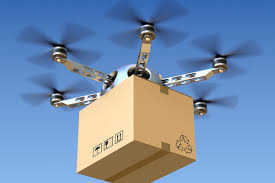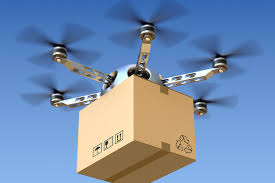
In what is being seen as a major technological change for the online retail business, Amazon’s delivery drones can now recharge and pick up packages from docking stations.
Amazon, one of the world’s largest online retailing firms and an e-commerce giant, would now be allowed to build such docking stations on tall structures such as lampposts or churches and allow the unmanned vehicles to do their business. A patent for this idea and technology has been recently granted to the US e-commerce firm.
"The docking stations may incorporate a number of features to enable UAVs (unmanned aerial vehicles) to fly longer routes, to fly routes more accurately, and to provide shelter during adverse conditions," Amazon's U.S. Patent and Trademark Office (USPTO) filing said.
Getting regulations that supports its plan to deliver parcels by unmanned flying machines passed by the government is the major task at hand for Amazon and the company is currently grappling with regulators to do so. This is so because new rules that essentially killed off Amazon's drone plans were issued by the Federal Aviation Administration (FAA) towards the end of June.
Despite this set back, testing of its drones and filing of patents for the same are being carried out by the U.S. e-commerce giant.
Cell towers, church steeples, office building, electric poles, and generally tall structures have been described as places where the company can set up docking stations according to the latest patent. Recharging or refueling, dropping off and picking up of packages, land and avoid bad weather would be allowed according to the new patent and the docking stations.
A system that would help communicate with each docking station through a "central control system" has been outlined in the patent and in the idea of docking stations for the delivery drones. The control system would be able to redirect a drone along a path with the most favorable conditions, for example, with the least wind and also would calculate the most direct route for a drone to follow. Since the drones are unlikely to be able to travel very large distances, the ability to recharge atop these docking stations is also very useful.
Packages can also be transferred at these docking stations by a drone. A package could be moved down from a docking station via a "vacuum tube, dumbwaiter, elevator, or conveyor" to a delivery person on the ground after a drone lands there and delivers a package.
Local free or fee-based internet services in public areas "without bearing the burden of installing some, or all, of the necessary infrastructure" can also be provided by the docking stations which can also act as cell towers, Amazon also said. Additionally, to "generate additional revenue for the provider", the docking stations could be used for advertising, according to Amazon.
A plan developed by Amazon that outlines how the drones would "talk" to each other to plan routes and communicate was also granted a patent last year. Like with all patents, the idea may never come to fruition.
(Source:www.cnbc.com)
Amazon, one of the world’s largest online retailing firms and an e-commerce giant, would now be allowed to build such docking stations on tall structures such as lampposts or churches and allow the unmanned vehicles to do their business. A patent for this idea and technology has been recently granted to the US e-commerce firm.
"The docking stations may incorporate a number of features to enable UAVs (unmanned aerial vehicles) to fly longer routes, to fly routes more accurately, and to provide shelter during adverse conditions," Amazon's U.S. Patent and Trademark Office (USPTO) filing said.
Getting regulations that supports its plan to deliver parcels by unmanned flying machines passed by the government is the major task at hand for Amazon and the company is currently grappling with regulators to do so. This is so because new rules that essentially killed off Amazon's drone plans were issued by the Federal Aviation Administration (FAA) towards the end of June.
Despite this set back, testing of its drones and filing of patents for the same are being carried out by the U.S. e-commerce giant.
Cell towers, church steeples, office building, electric poles, and generally tall structures have been described as places where the company can set up docking stations according to the latest patent. Recharging or refueling, dropping off and picking up of packages, land and avoid bad weather would be allowed according to the new patent and the docking stations.
A system that would help communicate with each docking station through a "central control system" has been outlined in the patent and in the idea of docking stations for the delivery drones. The control system would be able to redirect a drone along a path with the most favorable conditions, for example, with the least wind and also would calculate the most direct route for a drone to follow. Since the drones are unlikely to be able to travel very large distances, the ability to recharge atop these docking stations is also very useful.
Packages can also be transferred at these docking stations by a drone. A package could be moved down from a docking station via a "vacuum tube, dumbwaiter, elevator, or conveyor" to a delivery person on the ground after a drone lands there and delivers a package.
Local free or fee-based internet services in public areas "without bearing the burden of installing some, or all, of the necessary infrastructure" can also be provided by the docking stations which can also act as cell towers, Amazon also said. Additionally, to "generate additional revenue for the provider", the docking stations could be used for advertising, according to Amazon.
A plan developed by Amazon that outlines how the drones would "talk" to each other to plan routes and communicate was also granted a patent last year. Like with all patents, the idea may never come to fruition.
(Source:www.cnbc.com)














